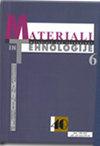MECHANICAL AND METALLURGICAL PROPERTIES OF FRICTION-STIR-WELDED AISI 304 STAINLESS STEEL
IF 0.8
4区 材料科学
Q4 MATERIALS SCIENCE, MULTIDISCIPLINARY
引用次数: 1
Abstract
Friction stir welding of AISI 304 stainless-steel sheets was successfully carried out with a tungsten-alloy (W+La2O3) tool and the effect of the tool rotational speed on the microstructure and mechanical properties of the joints were evaluated. 3-mm-thick plates were friction-stir welded at various rotational speeds of 600–1000 min–1 and a constant welding speed of 40 mm/min with a constant axial load of 15 kN. Defect-free joints were produced at 800 min–1 and 900 min–1, indicating a proper plastic flow of the material and ensuring adequate heat generation during welding. Tensile, Charpy impact, compression and microhardness tests were performed to evaluate the joint mechanical properties. The microstructural behavior of the welded and base-metal samples was examined with optical microscopy and scanning electron microscopy. According to the mechanical results, the welded material has a higher yield strength than the base metal due to the grain refinement and work hardening effect in the stir zone. FSW welds have a higher hardness than the base metal due to the high density of dislocations and continuous dynamic recrystallization. The joints also exhibit acceptable impact toughness. Finally, the EDS analysis confirms that there is no secondary-phase formation in the weld zone of the fabricated material.aisi 304不锈钢摩擦搅拌焊接的力学和冶金性能
采用钨合金(W+La2O3)刀具成功进行了AISI 304不锈钢板的搅拌摩擦焊接,并研究了刀具转速对接头组织和力学性能的影响。在恒定轴向载荷为15 kN的条件下,以600 ~ 1000 min - 1的不同转速和40 mm/min的恒定焊接速度对3 mm厚的钢板进行搅拌摩擦焊接。在800 min-1和900 min-1时产生无缺陷接头,表明材料塑性流动适当,并确保焊接时产生足够的热量。通过拉伸、夏比冲击、压缩和显微硬度测试来评估接头的力学性能。采用光学显微镜和扫描电镜对焊接试样和母材试样的显微组织行为进行了观察。力学结果表明,由于搅拌区的晶粒细化和加工硬化作用,焊接材料的屈服强度高于母材。由于位错密度高和连续动态再结晶,摩擦焊焊缝的硬度高于母材。接头也具有可接受的冲击韧性。最后,EDS分析证实,在焊接区没有二次相的形成。
本文章由计算机程序翻译,如有差异,请以英文原文为准。
求助全文
约1分钟内获得全文
求助全文
来源期刊

Materiali in tehnologije
工程技术-材料科学:综合
CiteScore
1.30
自引率
0.00%
发文量
73
审稿时长
4-8 weeks
期刊介绍:
The journal MATERIALI IN TEHNOLOGIJE/MATERIALS AND TECHNOLOGY is a scientific journal, devoted to original papers and review scientific papers concerned with the areas of fundamental and applied science and technology. Topics of particular interest include metallic materials, inorganic materials, polymers, vacuum technique and lately nanomaterials.
 求助内容:
求助内容: 应助结果提醒方式:
应助结果提醒方式:


